AP World Midterm (Next 38 Second Part of 45 Question Test - Next 24 Third Part from December 6th - Next 24 from December 7th - Next 23 From December 11th)
1/71
There's no tags or description
Looks like no tags are added yet.
Name | Mastery | Learn | Test | Matching | Spaced |
|---|
No study sessions yet.
72 Terms

Which of the following about the spread of agriculture is supported by the map above?
A. The global spread of agriculture reduced hunting and gathering peoples to a small
minority of humankind.
B. Agriculture originated in Africa and slowly spread outward to outlying core areas.
C. India received agricultural influences from the Middle East, and China.
D. Agriculture only arose where there was a scarcity of wild game
C. India received agricultural influences from the Middle East, and China
"If a [noble] man puts out the eye of another
[noble] man, his eye shall be put out.
If he breaks another [noble] man's bone, his
bone shall be broken.
If he puts out the eye of a [commoner] or breaks
the bone of a [commoner], he shall pay one
[silver] mina.
If he puts out the eye of a man's slave or breaks
the bone of a man's slave, he shall pay one-half
of its value."
2. The excerpt above from the Code of Hammurabi illustrates which of the following about
Babylonian society?
A. It made provision for the economic wellbeing of all classes.
B. It moved away from reliance on corporal punishment.
C. It was marked by social inequalities.
D. The king was regarded as blessed by divine forces.
It was marked by social inequalities.
Most early civilizations before 600 B.C.E. shared which of the following characteristics?
Urban centers, growing populations, and writing systems
Which of the following geographical advantages was shared by Egypt and
Mesopotamia?
Access to water for irrigation and other uses
5. What seems to be a goal of building the pyramids?
(A) Grain storage for times of famine
(B) Irrigation for Egypt's arid farmland
(C) Providing employment for farmers during the rainy season
(D) Demonstrating the authority and organizing power of the Pharaoh
Demonstrating the authority and organizing power of the Pharaoh
What was one effect of working on the pyramids?
Increased social cohesion
Historians often consider the Neolithic Era a turning point in the history of the world. Which of the
following events that occurred in that period best supports the contention?
A. Transoceanic migrations spread human populations outside of the African continent.
B. Development of pottery and basketry decreased food-storage capabilities
C. Denser populations, specialized labor, and complex social relations led to cities.
D. Humans abandoned slash-and-burn food production and focused on foraging.
C. Denser populations, specialized labor, and complex social relations led to cities.
All of the following were sites of early agriculture EXCEPT
A. Rhine Valley
B. Huang He Valley
C. Indus Valley
D. Tigris & Euphrates Valley
Rhine Valley
The development of writing led to all of the following advantages for a more complex
society EXCEPT
A. centralized records of tax payments, land ownership, and contracts.
B. centralized rule and enforcement of government regulations.
C. empowered village peasants and slaves to fight for their rights.
D. increased body of knowledge passed from one generation to another.
C. empowered village peasants and slaves to fight for their rights
11. Nomadic pastoralists differed from hunter-gatherers because they herded
domesticated animals in plains regions of Asia, Australia, Africa, and the Americas.
Advantages of domesticated animals include which of the following?
I. An absolute military power.
II. A steady source of protein.
III. Degree of mobility.
IV. The continuation of slash-and-burn agriculture.
A. I, III, and IV
B. II and III
C. I and IV
D. II, III, and IV
B. II and III
"The Way of husband and wife is intimately connected with Yin and Yang and relates the individual to gods and ancestors. Truly it is the great principle of Heaven and Earth, and the great basis of human relationships... If a husband is unworthy, then he possesses nothing by which to control his wife. If a wife is unworthy, then she possesses nothing which to serve her husband. If a husband does not control his wife, then the rules of conduct manifesting his authority are broken. If a wife does not serve her husband, then the proper relationship between men and women and the natural order of things are neglected and destroyed... Yet to only teach men and not to teach women—is that not ignoring the essential relationship between them? ...It is the rule to begin to teach children to read at the age of eight years, and by fifteen they ought then to be ready for cultural training. Only why should it not be that girls' education as well as boys' be according to this principle?"
12. The argument made by the author of the above stimulus most clearly supports which of the
following traditional Chinese beliefs?
(A) Change should only occur after consulting with ancestors
(B) A strong society consists of hierarchy in family affairs and government business
(C) Boys and girls must both be educated for the good of a peaceful society
(D) Husbands and wives were to have equal roles in the household to maintain the balance
B) A strong society consists of hierarchy in family affairs and government business
13. The importance of Yin and Yang, as described above, most likely shows the influence of which of
the following?
(A) Daoism
(B) Buddhism
(C) Legalism
(D) Confucianism
Confucianism
"The Way of husband and wife is intimately connected with Yin and Yang and relates the individual to gods and ancestors. Truly it is the great principle of Heaven and Earth, and the great basis of human relationships... If a husband is unworthy, then he possesses nothing by which to control his wife. If a wife is unworthy, then she possesses nothing which to serve her husband. If a husband does not control his wife, then the rules of conduct manifesting his authority are broken. If a wife does not serve her husband, then the proper relationship between men and women and the natural order of things are neglected and destroyed... Yet to only teach men and not to teach women—is that not ignoring the essential relationship between them? ...It is the rule to begin to teach children to read at the age of eight years, and by fifteen they ought then to be ready for cultural training. Only why should it not be that girls' education as well as boys' be according to this principle?"
14. The argument made by the author of the stimulus most clearly supports which of the following
A) The husband may take a second wife or concubine if his wife does not fulfill her subservient role
B) It is of equal importance that boys and girls are educated
C) Women will upset the Yin and Yang by working outside of the home
D) The Mandate of Heaven will end if a man does not have control of the household:
B) It is of equal importance that boys and girls are educated
"None cometh from thence
That he may tell us how they fare.
Lo, no man taketh his goods with him.
Yea, none returneth again that is gone thither."
-The Song of the Harp Player.
15. The song lyrics above by a 22nd century B.C.E. Egyptian would seem to be at odds with
A. the existence of ancient trade routes between Mesopotamia and Egypt
B. the civil wars that characterized many of the dynasties of ancient Egypt
C. the social customs that arose in part from the regular flooding of the Nile
D. the Egyptian practice of entombing pharaohs with "burial goods" needed in the afterlife
D. the Egyptian practice of entombing pharaohs with "burial goods" needed in the afterlife
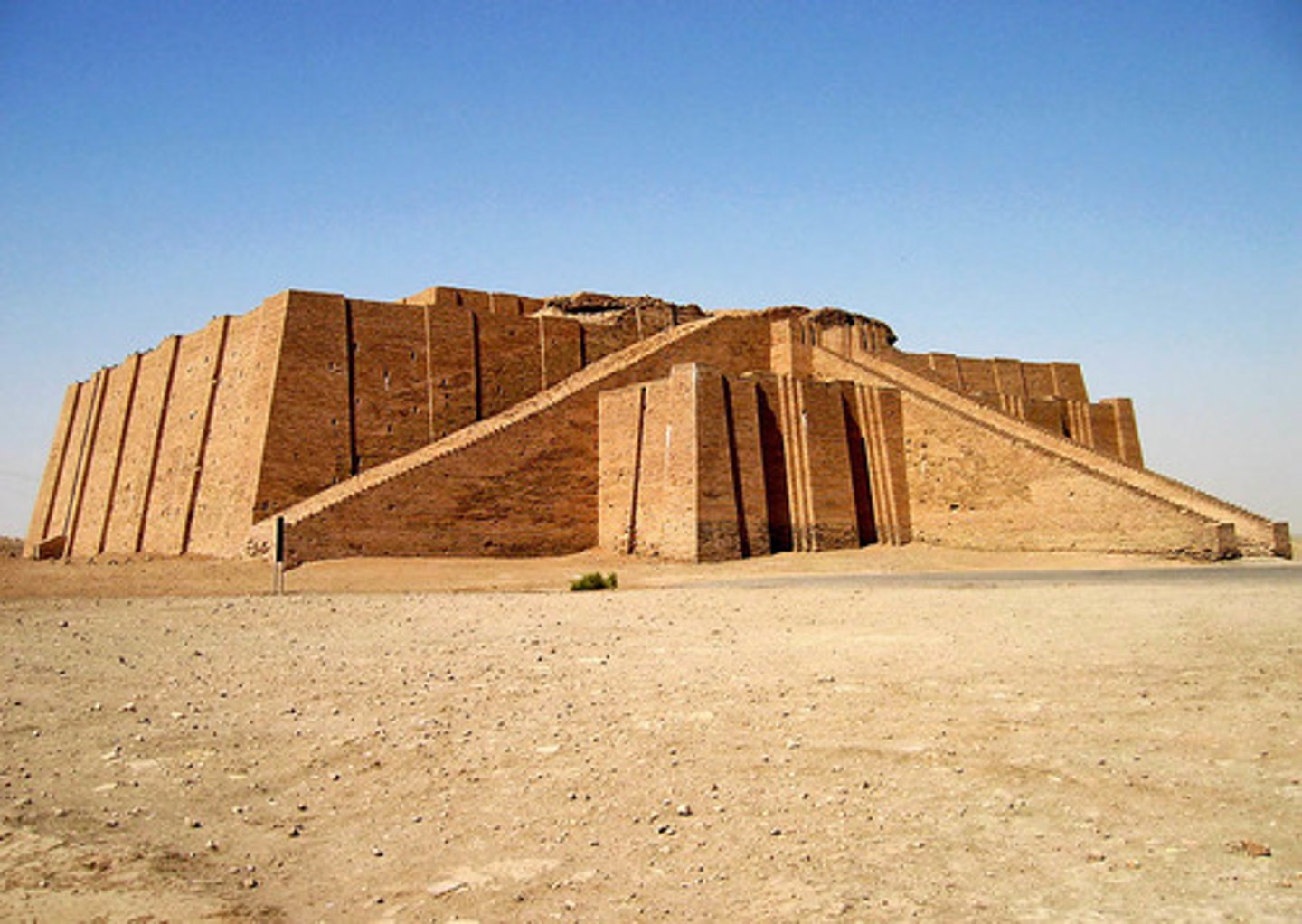
16. The ziggurat shown above, built in the 21 st century B.C.E., in the ancient Sumerian city of Ur, is an
example of
A. terraced palace gardens
B. a worship place and administrative center
C. a granary
D. an early astronomical observatory
B. a worship place and administrative center
'You shall not make for yourself a graven image, or any likeness of anything that is in Heaven
above, or that is on the Earth beneath, or that is in the water under the earth; you shall not
bow down to them or serve them; for I the Lord your God am a jealous God...' "
-The Book of Deuteronomy
17. What is the importance of the above excerpt?
A. It enforces the doctrinal belief in the Christian Creation story.
B. It establishes a belief in the Tribulation where God will destroy the earth due to man's sin.
C. It establishes the Jewish holiday of Passover in which Jews remember and honor the Exodus out
of Egypt.
D. It establishes the principle monotheistic worship in Judaism.
D. It establishes the principle monotheistic worship in Judaism.
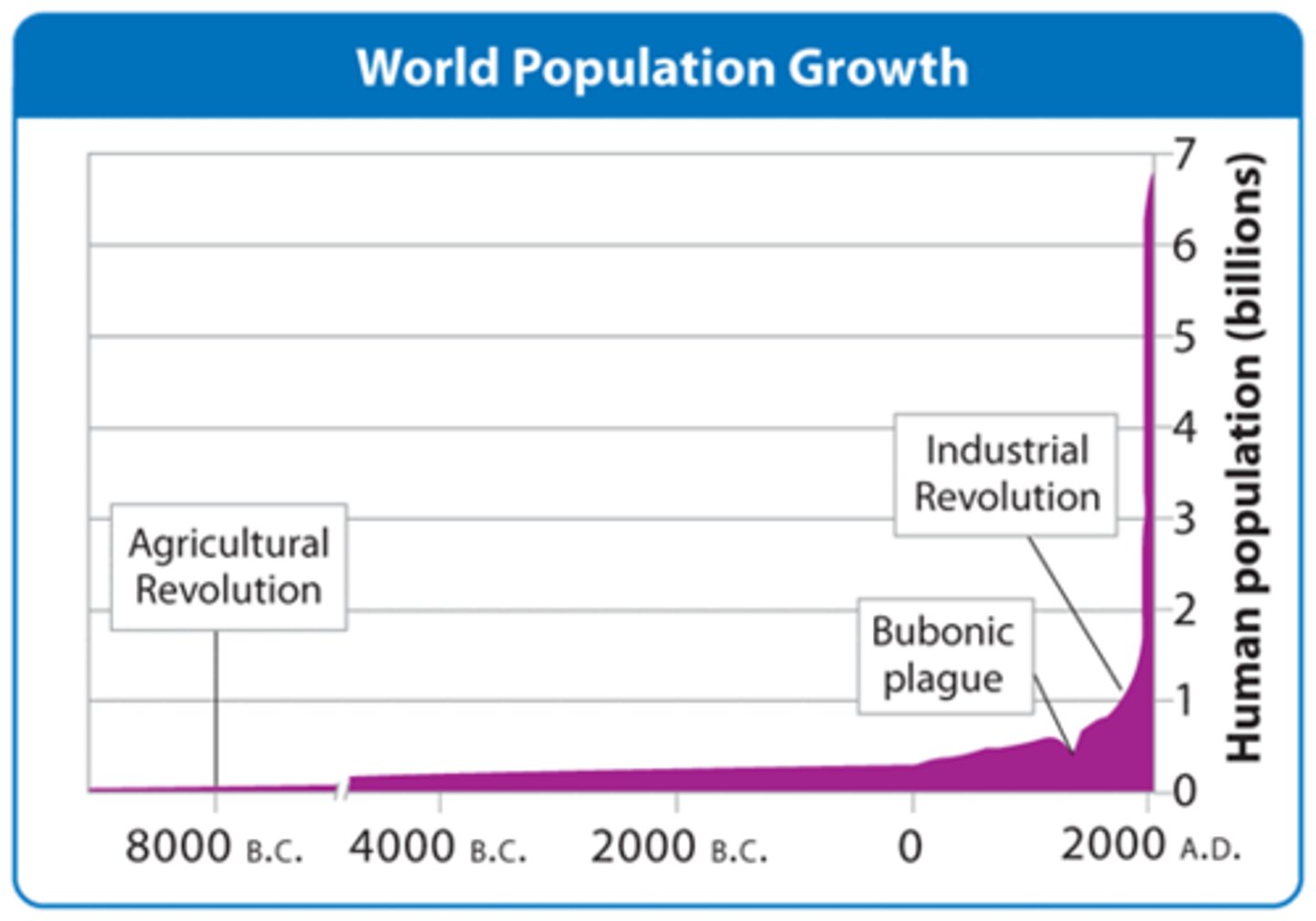
18. The trend shown at 8000 BCE on the graph above is best explained by
A. the widespread diffusion of agricultural practices
B. a sharp decline in the number of wars
C. climate change that resulted in lower average temperatures
D. migration of prehistoric humans in search of animals to hunt
A. the widespread diffusion of agricultural practices
"In those days the dwellings of Agade were filled with gold, its bright -shinining houses were filled with silver, into its granaries were brought copper, tin, slabs of lapis lazuli, its silos bulged at its sides ... its quay where the boats docked were all hustle ... All of this and more came from far away"
Sumerian
19. The information contained in the primary source would MOST help a historian of early
civilizations conclude that Agade was a city that
A. had high levels of social inequality.
B. participated in a larger regional trading network.
C. served as the political capital of Mesopotamia.
D. worshiped a religion that was polytheistic in nature.
B. participated in a larger regional trading network.
Which of the following groups had access to the greatest amounts of iron during this time period, which
led to territorial expansion and greater power?
A. Hittites
B. Sumerians
C. Egyptians
D. Olmec
Hittites
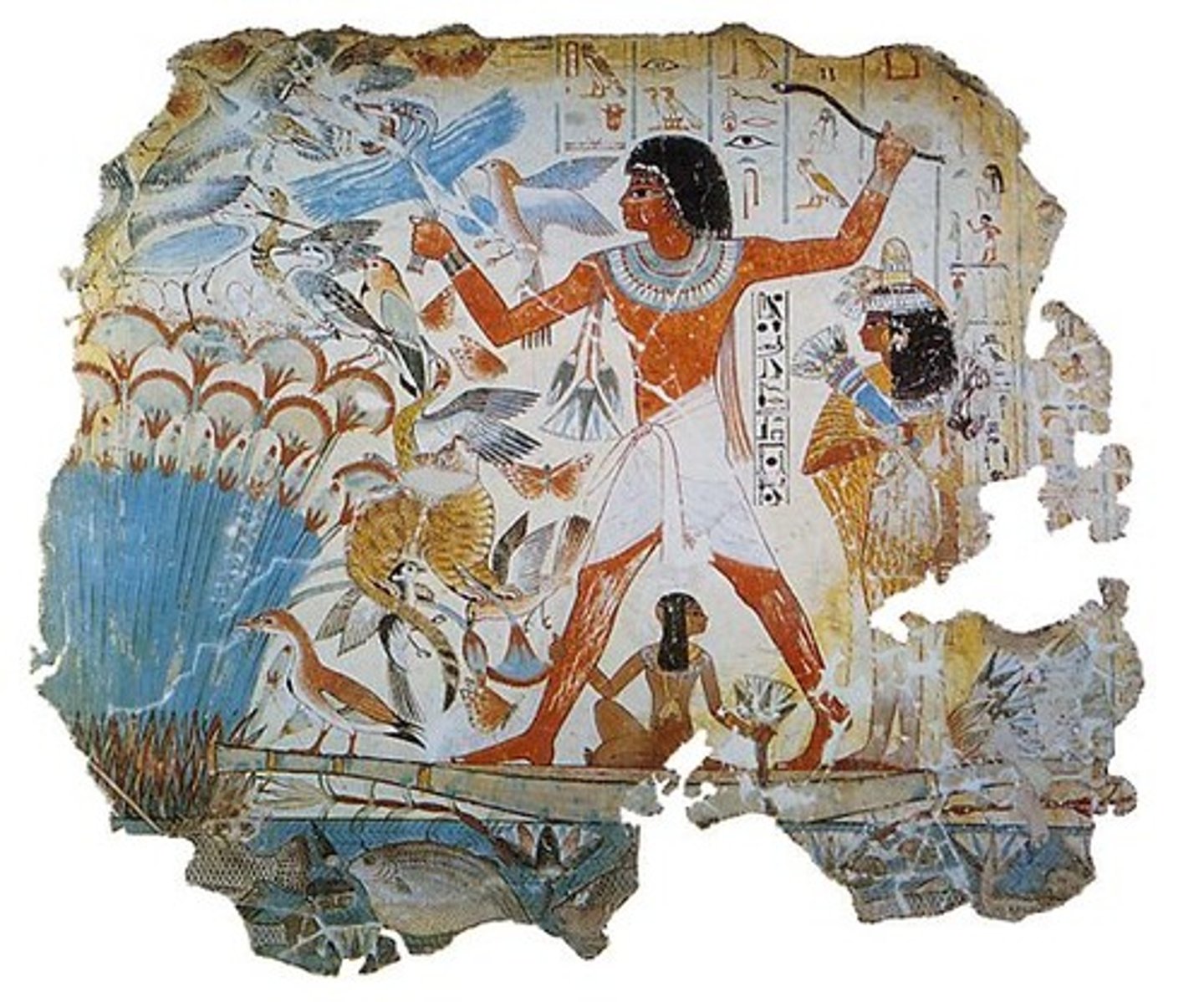
21. Some historians have tried to explain the origins of patriarchy. The evidence found in this
painting from ancient Egypt would support which of the following arguments?
(A) Women are identified with natural forces, but civilizations value culture more highly.
(B) Hunting and foraging led to the dominance of men who could control food supplies.
(C) The physical labor required by plowing gradually privileged male power.
(D) Private property and commerce were conducted by the men of the first civilizations.
(C) The physical labor required by plowing gradually privileged male power.
22. The painting includes hieroglyphics. The development of cuneiform, hieroglyphics, and
other types of record keeping was important partly because
a. their uniformity allowed different river valley civilizations, such as Egypt and
Mesopotamia, to communicate with each other
b. they encouraged the creation of an elaborate written law code that was codified, diffused,
and adapted throughout the river valleys
c. they helped organize elaborate political structures, such as the city-states of Mesopotamia
and the dynastic empires of China
d. they allowed for the increased cultivation of certain types of plants throughout the world
as different groups shared ideas through records
c. they helped organize elaborate political structures, such as the city-states of Mesopotamia
and the dynastic empires of China
Among [the] cultural heroes admired by the Chinese, Yu is particularly interesting, for his contribution
was flood control and irrigation . . . . These myths, which cannot be fitted into any time framework
established by archaeology, show that, although China has fought many cruel wars, the ideal has
always been that of peaceful cultural achievement rather than feats of battle. The legend of Yu
demonstrates that the needed culture hero is one who can organize men and make them combine to
combat the natural disaster of a flood on a vast scale.
W. Scott Morton & Charlton M. Lewis, from China: Its History and Culture.
23. Even though no timeframe can be established for the origin of the Yu myths by archeology,
the subject matter of the myths suggest they originated
(A) as a consequence of the Zhou invasion that ended the Shang dynasty
(B) during China's Neolithic period
(C) after China entered its Iron Age
(D) well after the establishment of early Chinese civilization
(B) during China's Neolithic period
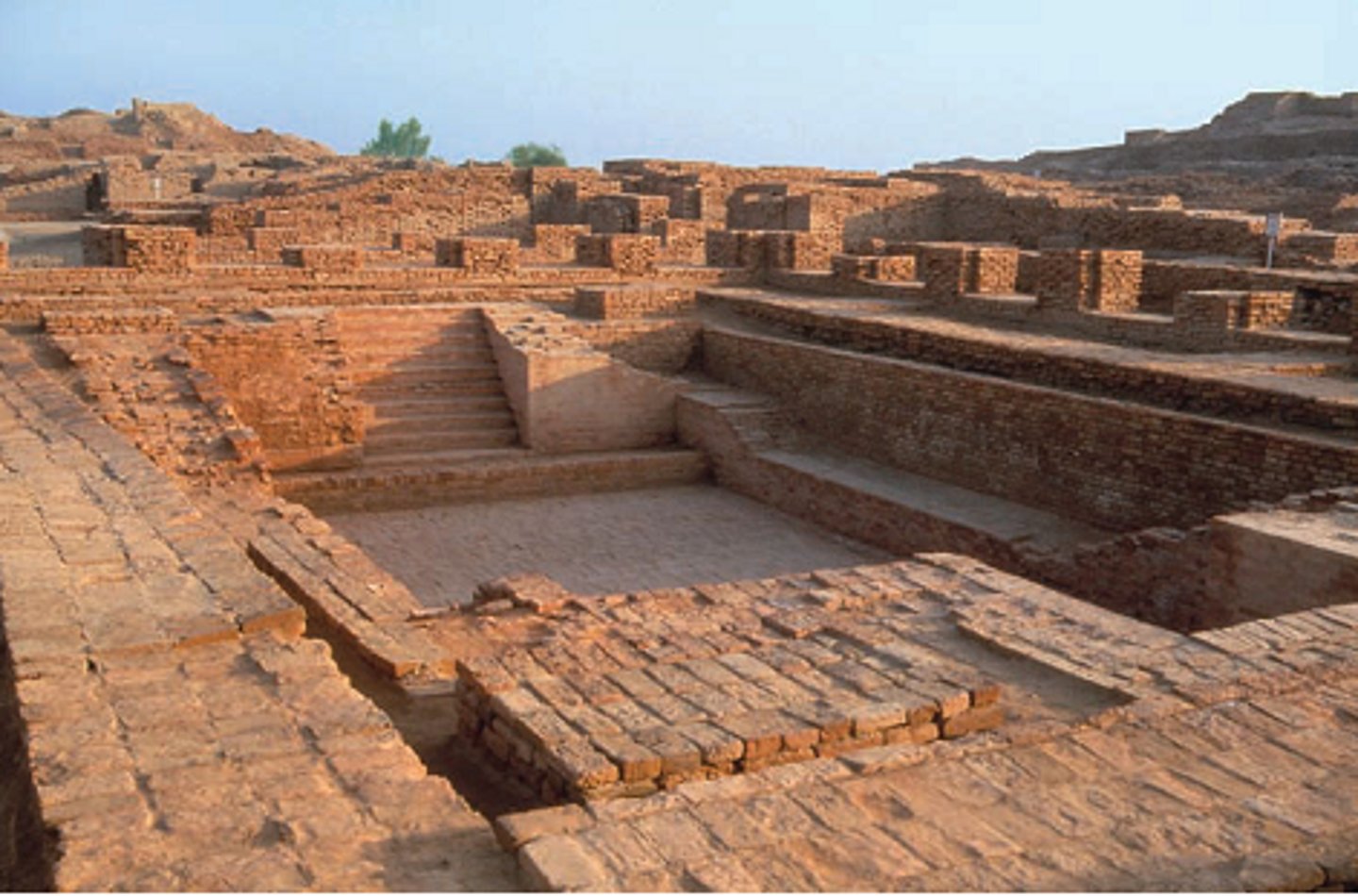
24. The above photo from Mohenjo-Daro represents what impressive feature?
A. A massive storage facility for grains such as maize and millet
B. A large water reservoir that was used for cleansing and other rituals
C. A meeting hall where governmental decisions were likely held
D. A burial chamber for one of the leaders of the civilization
B. A large water reservoir that was used for cleansing and other rituals
From before the time of Yao and Shun [third millennium BCE], there have been barbarians... living in northern uncivilized areas and wandering around herding animals. They herd mainly horses, cattle, and sheep, but also some unusual animals, such as camels, donkeys, mules, and wild horses... They move around looking for water and pasture and have no walled settlements or permanent housing. They do not farm... They have no writing... [They] use bows and arrows to shoot birds and rodents... foxes and rabbits for food. It is their custom when times are easy to graze their animals and hunt with the bow for their living, but when hard times come, they take up weapons to plunder and raid. This is their innate nature... They are only concerned with self-interest, knowing nothing of proper behavior or justice.
SOURCE: Sima Qian, How Others Live: The Customs of the Xiongnu (Han Dynasty historian) As
recorded in Thomas R. Martin, Herodotus and Sima Quan,The First Great Historians of Greece and
China: A Brief History with Documents (2010): pp. 129-130, Boston, MA: Bedford/St. Martin's.
25. Which detail from the selection best supports the assertion that the Xiongnu lived a pastoral
lifestyle?
(A) They moved around looking for water
(B) They herd mainly horses, cattle, and sheep
(C) They do not farm
(D) They are concerned only with self-interest
(A) They moved around looking for water
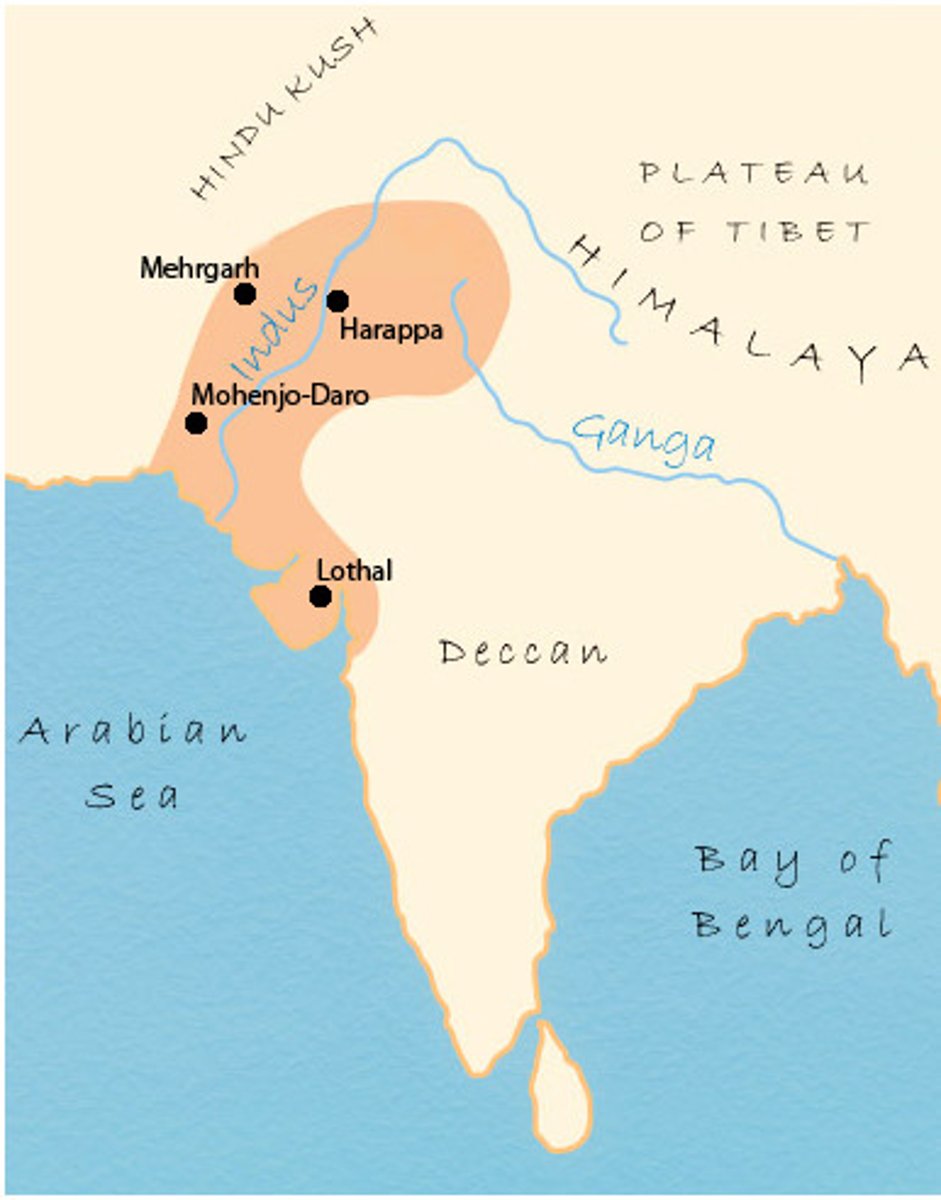
What is this civilization?
Harapan
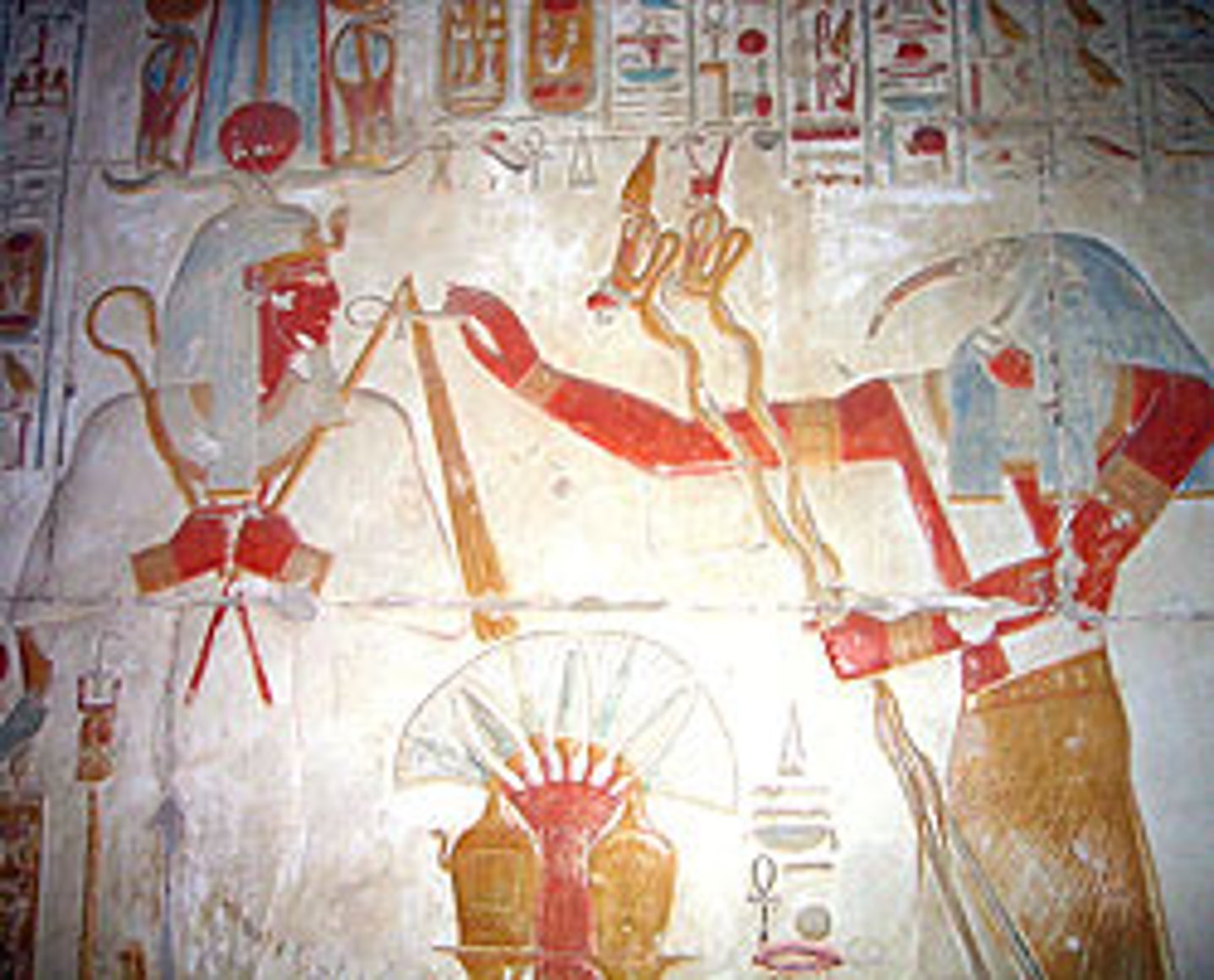
Compare the images above: What do the images suggest about Egyptian and Mesopotamian
civilization?
They had an organized political system with a divine king at the head of power.
28. Which is the best explanation (out of those given below) for patriarchy in early civilizations?
A. With private property and the desire to insure that a father's own offspring inherit, sharp
restrictions were placed on women's sexual activities.
B. Men were better suited to learn writing than women.
C. Women had a much higher mortality rate than men because they died so frequently during
childbirth.
D. Women were often associated with buildings and pottery which were considered fake
compared to the vastness of nature.
A. With private property and the desire to insure that a father's own offspring inherit, sharp
restrictions were placed on women's sexual activities.
29. Which is the best geographical reason to explain why the outlook on life of
Mesopotamians, as related in some of its literature, seems much more pessimistic than
that in Egypt?
a. Mesopotamia had few natural resources available, unlike in Egypt.
b. The climate of Mesopotamia was more arid than Egypt causing desert-like conditions.
c. Mesopotamia's geography was much more mountainous than that of Egypt.
d. Mesopotamia's rivers flooded unpredictably and dangerously while the Nile was always
predictable and helpful.
d. Mesopotamia's rivers flooded unpredictably and dangerously while the Nile was always
predictable and helpful.
Epic of Gilgamesh
"who had stood in the place of gods like Anu
[King of the gods] and Enlil [God of the sky],
stood now like servants to fetch baked meats in
the house of dust, to carry cooked meat and cold
water from the waterskin.'
Book of Exodus
"And God spoke all these words, saying, 'I am the
Lord your God, who brought you out of the land
of Egypt, out of the house of bondage. You shall
have no other gods before me."
After reading the excerpts from Mesopotamia (Gilgamesh) in 2000 BCE and the Egyptian
Hebrews (Book of Exodus) in 900 BCE what can you infer about the two societies and their
belief systems?
a. Mesopotamian society put more emphasis on the belief in many gods, whereas the
Hebrews' focus was on a single god.
b. Both societies developed belief systems focused on the worship of one single god.
c. The Hebrews in Egypt put more emphasis on the belief in many gods, whereas the
Mesopotamian's focus was on a single god.
d. Both societies rejected the notion of any spiritual higher power
Mesopotamian society put more emphasis on the belief in many gods, whereas the
Hebrews' focus was on a single god.
31. The war chariot shown in the image best reflects evidence of the Zhou dynasty's attempts to
A. Control and suppress local ruling elites.
B. Protect against nomadic raids from central Asia.
C. Enforce and regulate trade networks.
D. Extend military control over large regions.
Extend military control over large regions.
32. The inclusion of material goods and sacrifices in the tomb image is most directly related to
which of the following?
A. The influence of shamanism
B. A reliance on oracles and divination.
C. The concept of mandate of heaven
D. The practice of ancestor veneration
D. The practice of ancestor veneration
What theory of politics was used by the Zhou to justify the deposition of the Shang dynasty?
A. Mandate of Heaven
China was isolated and unknown to other civilizations mostly due to its
philosophy
Mesopotamian merchants travelling to the Indus River Valley to exchange goods:
Displays trade going from local to regional
Excerpt I. Analects. 27 June 2016. http://afe.easia.columbia.edu/ps/cup/confucius_govt.pdf. Web.
12:11 Duke Jing of Qi asked Confucius about government. Confucius replied, "Let the
ruler be a ruler; the minister, a minister; the father, a father; the son, a son."
Excerpt II. Laws of Manu. 27 June 2016. http://legacy.fordham.edu/halsall/india/manu-full.asp.
Web
87. But in order to protect this universe He, the most resplendent one, assigned separate
(duties and) occupations to those who sprang from his mouth, arms, thighs, and feet.
88. To Brahmanas he assigned teaching and studying (the Veda), sacrificing for their own
benefit and for others, giving and accepting (of alms).
89. The Kshatriya he commanded to protect the people, to bestow gifts, to offer sacrifices, to
study (the Veda), and to abstain from attaching himself to sensual pleasures;
90. The Vaisya to tend cattle, to bestow gifts, to offer sacrifices, to study (the Veda), to
trade, to lend money, and to cultivate land.
91. One occupation only the lord prescribed to the Sudra, to serve meekly even these (other)
three castes.
36. In both societies referenced above religions and belief systems were used to:
A. Establish divine descent of the ruler
B. Provide social order and economic essentials
C. Maintain harvest and planting routines
D. Educate women in their domestic duties
B. Provide social order and economic essentials
Which domesticated animal is most-closely associated with the Americas and early
civilizations?
A. Horses
B. Cattle
C. Llamas
D. Goats
C. Llamas
Which of the following technological innovations most contributed to the military success
of empires in Egypt, Anatolia, and Mesopotamia in the period 1500 - 1000 BCE?
A. city walls and castles
B. chariots and compound bows
C. catapults and crossbows
D. canals and warships
B. chariots and compound bows
Mesoamericans did not develop pastoral communities like other regions in the world
because
A. They had domesticated wheat and barley
B. They outstripped their natural resources which led to drought
C. They developed terrace farming
D. They lacked large domesticated animals for protein and power
D. They lacked large domesticated animals for protein and power
Even though the origin of agriculture was not inevitable, several factors caused people living in
the Fertile Crescent to begin altering their daily routines in ways that would gradually develop
into the practice of agriculture. Growing wild in the semi-arid grasslands of this region was an
unusual variety of edible wild grains that were ideal for domestication.
At first, people picked wild grains and legumes because they were available, tasted good, and
during a particular season were one ingredient among many sources of food. This was
"gathering," not agriculture. But by 11,000 years ago, cereals related to wild varieties of grain
began to appear as clear evidence of human intervention and manipulation. People repeatedly
picked the largest grains or vegetables because more food could be gathered in less time by
doing so. This selection process was initially unconscious, simply a matter of common sense and
efficient use of time, but it gradually produced results similar to what agricultural specialists
have consciously done in recent centuries to develop improved strains of crops.
Slowly, over the centuries, humans and the grains they grew gradually became more
interdependent. As people continually selected the largest seeds, their crops evolved into
hybrids incapable of surviving in the wild against natural competition from other vegetation.
—William F. Ruddiman, paleoclimatologist, Plows, Plagues, and Petroleum, published in 2010
40. According to the excerpt, what was the relationship between early humans and the
environment in the Fertile Crescent?
A. Severe resource limits raised a constant threat of starvation, which drove gatherers to consciously
breed the most productive food crops.
B. The fertile floodplain attracted early hunter-gatherers and encouraged their adoption of a sedentary
lifestyle, which necessi
C. Abundant wild cereal grains provided nutrition for early humans, who gradually domesticated plants
and developed hybrids that were not able to survive in the wild.
Even though the origin of agriculture was not inevitable, several factors caused people living in
the Fertile Crescent to begin altering their daily routines in ways that would gradually develop
into the practice of agriculture. Growing wild in the semi-arid grasslands of this region was an
unusual variety of edible wild grains that were ideal for domestication.
At first, people picked wild grains and legumes because they were available, tasted good, and
during a particular season were one ingredient among many sources of food. This was
"gathering," not agriculture. But by 11,000 years ago, cereals related to wild varieties of grain
began to appear as clear evidence of human intervention and manipulation. People repeatedly
picked the largest grains or vegetables because more food could be gathered in less time by
doing so. This selection process was initially unconscious, simply a matter of common sense and
efficient use of time, but it gradually produced results similar to what agricultural specialists
have consciously done in recent centuries to develop improved strains of crops.
Slowly, over the centuries, humans and the grains they grew gradually became more
interdependent. As people continually selected the largest seeds, their crops evolved into
hybrids incapable of surviving in the wild against natural competition from other vegetation.
—William F. Ruddiman, paleoclimatologist, Plows, Plagues, and Petroleum, published in 2010
41. Based on the excerpt, which statement best describes how farming in the Fertile Crescent during
the Neolithic period connects to broader historical processes?
A. It illustrates early humans' development of specialization and division of labor in response to
changing environmental conditions.
B. It illustrates a shift away from hunter-gatherers' dependence upon animal sources for the m
D. It shows how the transition from hunting and gathering to agriculture provided a more reliable food
supply, which fostered settlements and supported population increases.
Which people are credited with developing the first phonetic alphabet?
A. Egyptians
B. Sumerians
C. Phoenicians
D. Chinese
E. Koreans
Phoenicians
Which statement is most accurate regarding Jewish monotheism?
A. It traces its origins to Abraham
B. It was spread by missionaries in the Ganges River Valley
C. It appealed mainly to wealthier people
D. It incorporated the idea of reincarnation
E. It rejected all the laws of Mesopotamian civilization
A. It traces its origins to Abraham
Which of the following did ancient Egyptian, Shang, and Sumerian civilizations all have
in common?
A. Pyramid-shaped monumental architecture
B. River valley location
C. Acceptance of Buddhism
D. Pastoral-based economy
E. Intensive rice agriculture
B. River valley location
Which of the following types of evidence would most strongly support the theory that
the Americas were first populated by people migrating across a land bridge that
connected Northeast Asia and North America?
A. The discovery of pottery from Ming China at a pre-Columbian site in Peru
B. American Indians' lack of immunity to many diseases endemic to Afro-Eurasia
C. Data showing a close genetic relationship between American Indians and indigenous peoples of Siberia
D. Architectural similarities between the pyramids of Teotihuacán, Mexico, and Giza, Egypt
C. Data showing a close genetic relationship between American Indians and indigenous peoples of Siberia
Archaeological evidence indicates that Paleolithic hunter-gatherer societies used
which of the following technologies?
A. Smelting of metals such as copper and iron
B. Controlled use of fire for warmth and as an aid in hunting and foraging
C. Systems of written symbols to preserve knowledge of favorable hunting and gathering sites
D. Harnesses and other tools to control draft animals
B. Controlled use of fire for warmth and as an aid in hunting and foraging
The Mesopotamian law code is well known and famous. Why didn't Egypt have a
similar code of law?
A. It was left to the people to determine the code of morality.
B. The wealthy merchant class controlled the legal system.
C. The common law system based on precedent was used.
D. The pharaoh as god on earth was the source of all law.
D. The pharaoh as god on earth was the source of all law.
Which ancient civilization fits the description found below:
*Constructed multistory structures
*Arose near the Indus River
*Disappeared for reasons that remain unclear
A. Harappan
B. Shang
C. Kushite
D. Mayan
E. Mauryan
Harappan
Which people are generally credited with founding Mesopotamian civilization in the
Tigris-Euphrates River Valley?
A. Akkadians
B. Hittites
C. Sumerians
D. Greeks
E. Phoenicians
C. Sumerians
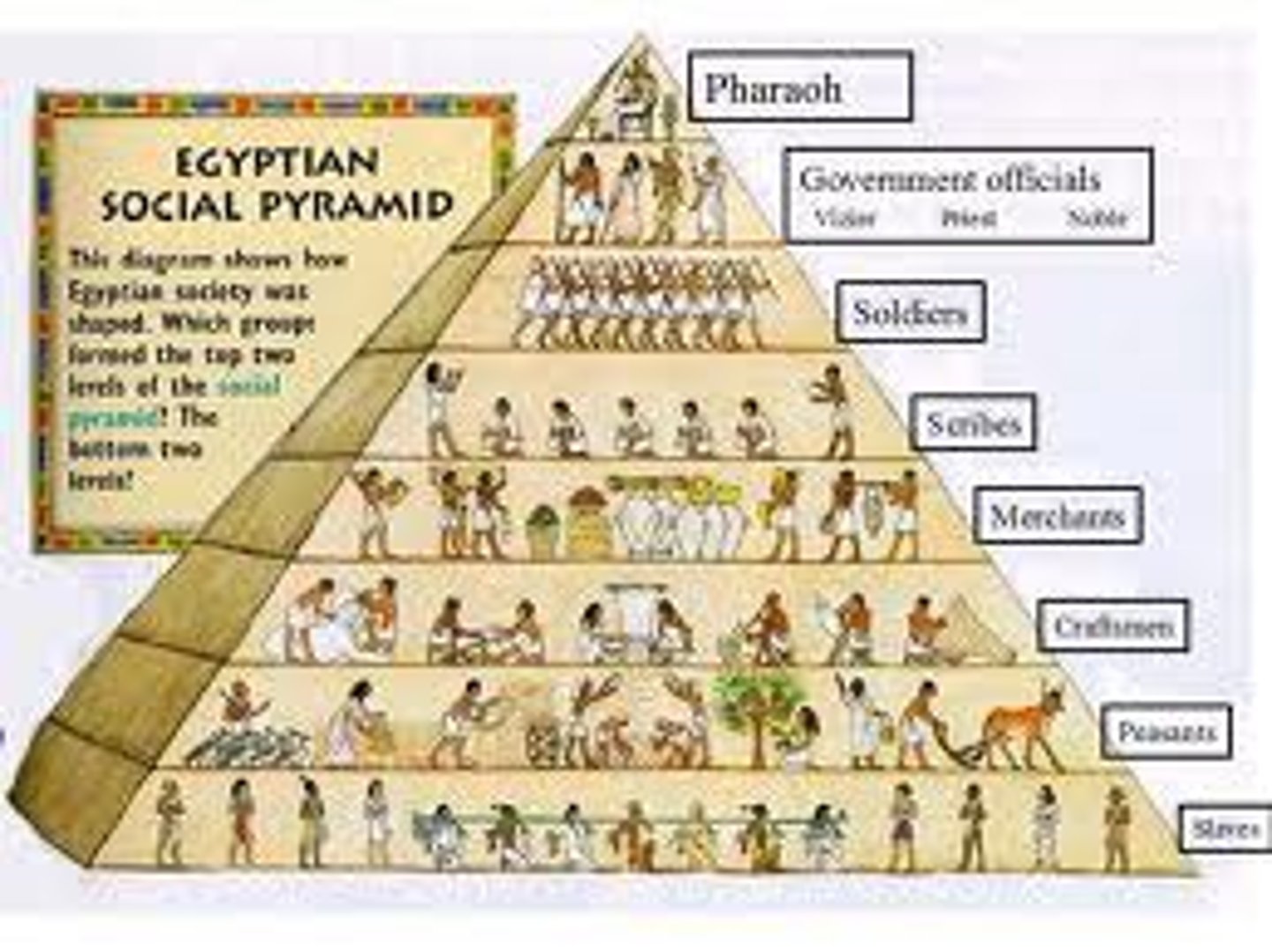
This illustration indicates
(A) the farmers were the most powerful group
(B) the highly stratified nature of this society
(C) that Egypt was polytheistic
(D) social class was not important
(E) society had not yet developed specialization
(B) the highly stratified nature of this society
What dynasty, along with the Sui, re-established and improved Chinese Civiliations after the fall of China's classical civilization?
Tang
All of the following empires are posclassical except
Tang
Ummayad Caliphate
Byzantine
Persian
Mongol
Persian
Constantinople and Malacca both were powerful because of what?
Strategic location
Why did the mongols refrain from attacking central Europe in 1241?
Death of the Great Khan
What important cultural movement rejected Buddhism while adapting some of its themes to te predominant thought which stressed family duty and honor?
Neo- Confucianism
In Japan, from the Heian period until the Tokugawa period, emperors
Seldom wielded
Which of the following best compares European and Chinese merchants in society during the early 15th century?
European merchants were bound to their lords in the feudal system and Chinese merchants were from the noble class
Merchants in Europe were important to the revival of long distance trade gaining status and wealth, while Chinese merchants used their wealth to buy higher status for their families
Chinese merchants were guarantee government support while European merchants were independent persons of the towns
European monarchs favored alliances with nobility against merchants and merchants under the Ming dynasty were favored over scholar gentry
Merchants in Europe were important to the revival of long distance trade gaining status and wealth, while Chinese merchants used their wealth to buy higher status for their families
The turkic expansion under Timur the Lame disrupted all of the following regions except
Persia
India
China
Southern Russia
Fertile Crescent
China
In what ways were the civilizations in Mesoamerica before 1000 CE more sophisticated than those in North America?
A. In the former, social structure was more complex, astronomical knowledge was greater, and architectural skills were
more advanced.
B. In the former, Christianity was already practiced.
C. Mexican and Central American civilizations never practiced human sacrifice, while societies in North America did.
D. The former civilizations adopted democracy, while the latter used tribal rule.
E. In no ways, because the North Americans had more advanced social structures.
A. In the former, social structure was more complex, astronomical knowledge was greater, and architectural skills were
more advanced.
In the five centuries after the year 1000 C.E. the peoples of the eastern hemisphere
A. cut off contact with the rest of the world because of the ravages of disease.
B. fell under the control of the expanding empires of the western hemisphere.
C. traveled and interacted more intensively than ever before.
D. fell dangerously behind the rest of the world in science and technology.
E. united into the largest empire the world had seen since the time of Rome.
C. traveled and interacted more intensively than ever before.
Which factor helps explain the scientific and literary achievements of the Muslims during their Golden Age?
A. expansion of transatlantic trade
B. innovations introduced by the Europeans during the Renaissance
C. cultural diversity accepted by many Islamic governments
D. legal equality of all people in the Islamic empire
E. the status of women in society.
C. cultural diversity accepted by many Islamic governments
All of the following trade routes existed prior to 1000 C.E. except the:
A. Silk Route
B. Arabia/India Ocean Route
C. Atlantic Ocean Route
D. China/India Route
E. Trans-Sahara Route
C. Atlantic Ocean Route
Zheng He... as ordered by the emperor, proceeded with their journey to the Western Ocean. Well furnished with
treasure and accompanied by more than 27,800 officers and men... What body of water is the "Western Ocean" in
reference to?
A. Atlantic Ocean
B. Mediterranean Sea
C. Indian Ocean
D. Pacific Ocean
E. Red Sea
C. Indian Ocean
Narratives such as Marco Polo's created a European
A. isolationist mentality.
B. image of Mongol poverty.
C. ambition to find easier routes to Asia.
D. fear of Mongol attack.
E. literary movement called romance writing.
C. ambition to find easier routes to Asia.
Which of the following was a result of the Crusades?
A. Western knights carved out a kingdom in the Holy Land that lasted until the sixteenth century.
B. The Fourth Crusade aided in the defense of Constantinople and preserved the integrity of the Byzantine Empire.
C. The Crusades demonstrated a new Western superiority in the wider world.
D. The Crusades helped to open the West to new cultural and economic influences from the Middle East.
E. The Muslims adopted much of Europe's culture.
D. The Crusades helped to open the West to new cultural and economic influences from the Middle East.
During the postclassical period, societies in the Americas
A. remained entirely separate from those of the Old World.
B. experienced the initial contacts that led eventually to European invasion of the New World.
C. failed to develop imperial forms of government, a failure that mirrored European society.
D. were united under a single government.
E. were isolated from Europe, but had limited contact with Africans.
A. remained entirely separate from those of the Old World
Which of the following was a source of Western dynamism in the fourteenth and fifteenth centuries?
A. The growing dominance of the Holy Roman Empire
B. Two centuries of peace among the major nations
C. The absence of epidemic disease
D. The growth of cities and urban economies
E. The Catholic Church's drive to reform
D. The growth of cities and urban economies
"Their men show no signs of jealousy whatever; no one claims descent from his father, but on the contrary from his
mother&'s brother. A person's heirs are his sister's sons, not his own sons." (Ibn Battuta) This is a description of
A. patriarchy
B. infanticide
C. matrilineal descent
D. independent origin
E. marriage dowers
C. matrilineal descent
Which of the following societies' gender roles was overall the most constrictive and gave the greatest amount of
freedom and rights to women?
A. India
B. China
C. Maya
D. Greece
E. Rome
C. Maya
Christians devotion to saints was very much like
A. the Bantu people devotion to the creator god
B. Buddhists devotion to Bodhisattvas
C. Muslims devotion to Mecca
D. the Jews devotion to the Torah
E. all of the above
B. Buddhists devotion to Bodhisattvas
Which of the following practices was common to the Aztec and the Inca empires?
A. Extensive use of sacrifice
B. A tribute system
C. A merchant class
D. A writing system
E. The quipu system
B. A tribute system
Merchants in southern post-classical India
A. would have been severely threatened by monsoon winds as their ships were not stable for Indian Ocean travel
B. were heavily taxed by Muslim overlords in Delhi which halted their expansion into Africa
C. were very acquainted with local temples as they were the source of banking and finance.
D. did not venture out from India because the Chinese and Europeans came to them.
E. had a very successful system of bartering so a money system never developed.
C. were very acquainted with local temples as they were the source of banking and finance.
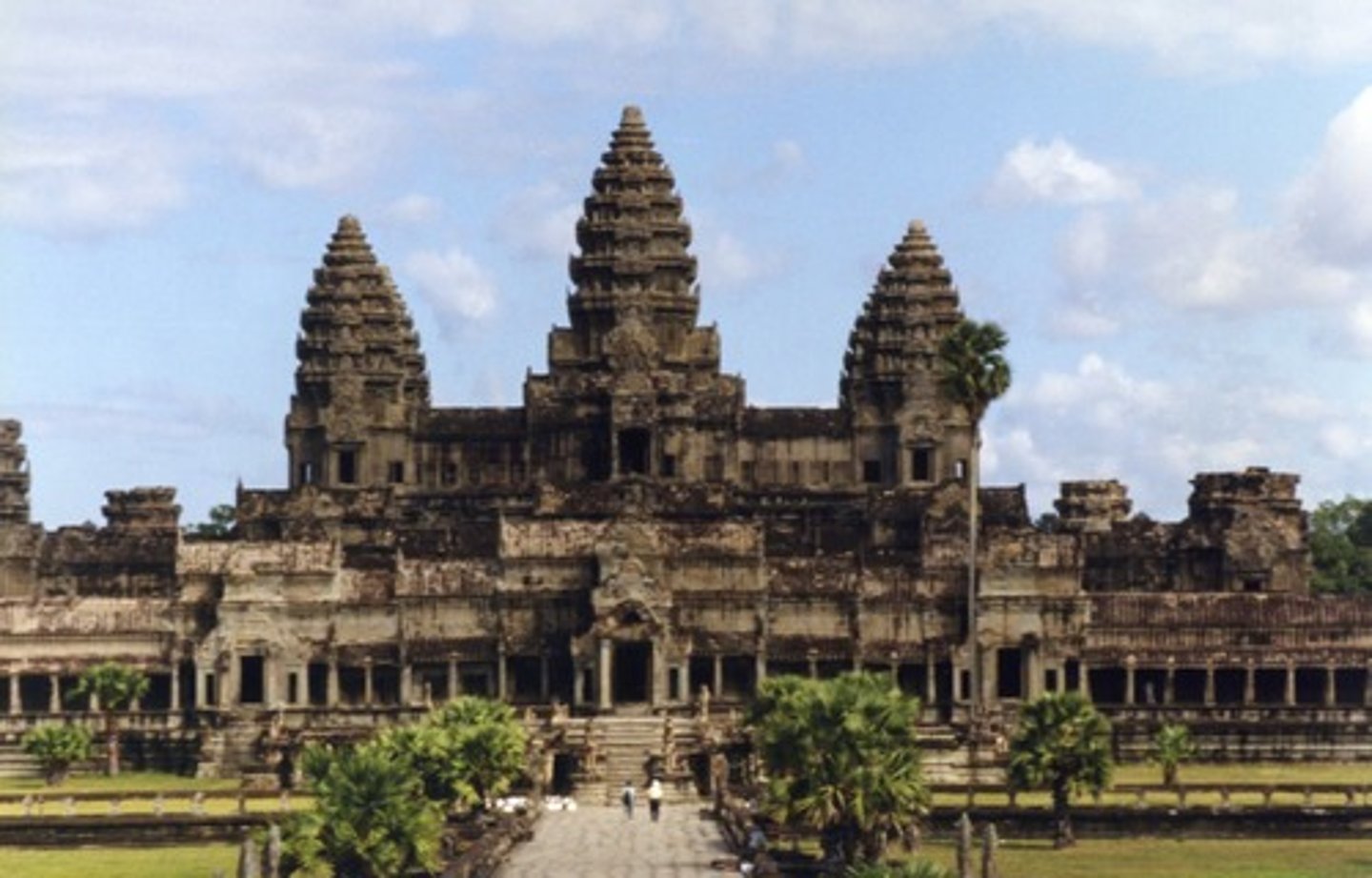
The architecture shown above is an example of
A. the spread of Christianity.
B. the spread of the Mongols.
C. the spread of Hinduism.
D. the spread of the Persians.
E. the spread of Islam.
C. the spread of Hinduism.